Growing Summer Squash Vertically
This post may contain affiliate links, which means that I may receive a commission if you make a purchase using these links. As an Amazon Associate I earn from qualifying purchases.
Summer squash are among the easiest and most productive plants to grow in the garden. They are fun to grow too since there are so many different shapes, colors, and varieties. Often times I find myself trying to squeeze in more varieties than I have room for in the garden.
Summer squash loves the summer heat, and usually begins producing within 60 days after planting and continues all season until frost, disease, or squash vine borer takes it out.
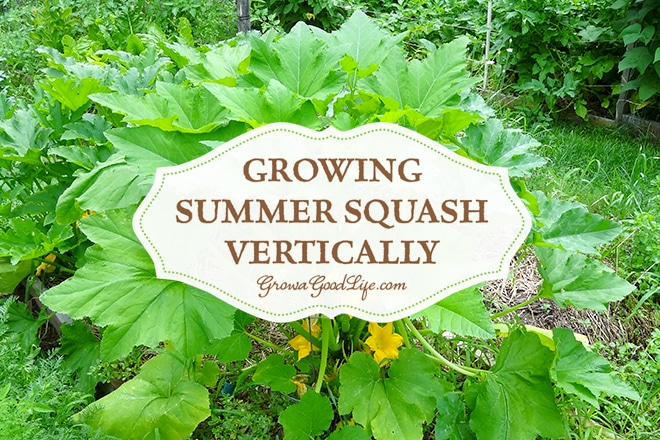
What is Summer Squash?
Squash is divided into two types, winter squash and summer squash. Summer squash differs from winter squash in that it is harvested young while it is still tender.
There are so many varieties of summer squash, including zucchini or courgette, patty pan or scallop, yellow crookneck, and yellow straight neck squash. Each type has many varieties, colors and shapes.
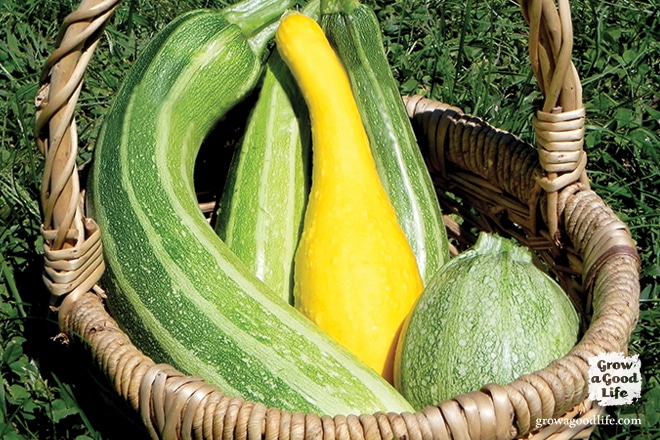
In contrast, winter squash has a thicker rind and is harvested in the fall, cured, stored, and consumed during the winter months. Common winter squash varieties include acorn, butternut, pumpkin, and spaghetti squash. Winter squash usually grows on long, rambling vines.
Most summer squash have a bushy growth habit. The fruit begins forming at the base of the stem and continues developing up the stalk as the plant grows. Even though summer squash plants are bush like, the stem of the plant does tend to lengthen a little as it grows.
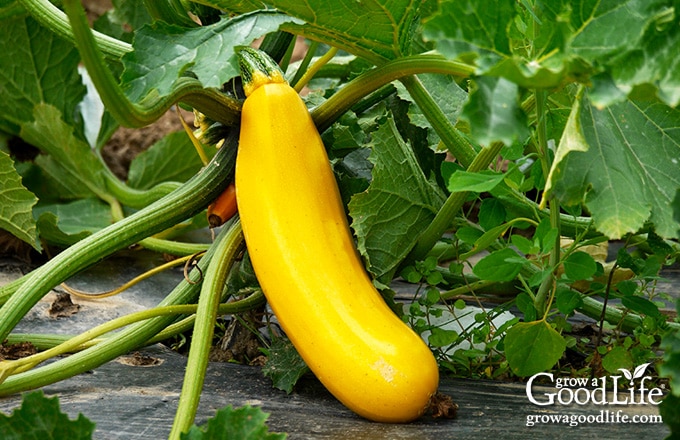
Since I have been converting my garden to permanent raised beds that are only 3-feet wide, I had to think of some creative ways to keep the summer squash confined to the bed and prevent it from flopping out into the aisles. For me, the logical answer was to grow summer squash vertically using tomato cages to support the plant and keep it upright.
Benefits of Growing Summer Squash and Zucchini Vertically
Although the reason I wanted to grow summer squash upright was to save space, I quickly discovered that growing summer squash and zucchini in tomato cages had other benefits as well.
- Growing summer squash vertically saves space. The plants can easily be trained to remain in the tomato cage as it grows. The cage provides support and keeps the plant upright, preventing it from flopping out of the growing bed into the walking paths.
- Growing zucchini upright encourages air movement. Good air circulation around the plant helps the foliage stay dry and averts downy mildew and other fungal diseases.
- Vertical growth keeps the squash off the ground. There is less chance of the fruit rotting from excess moisture since the squash is not touching the ground.
- It’s easier to see the zucchini to harvest. Growing upright allows the squash to be more visible reducing the chance of overgrowth. No more giant zucchinis!
- More light gets to the plant when growing upright. Zucchini and summer squash thrive in sun. Since the foliage is more spread out when growing upright, there is less shading allowing the plant to absorb more sunlight. Also, most pollinators prefer to forage in sun.
- Less places for squash bugs and other pests to hide. Squash bugs, cucumber beetles and other pests have less area to hide near the ground. Also, since the foliage is upright, it is easier to scout for and destroy eggs before they hatch.
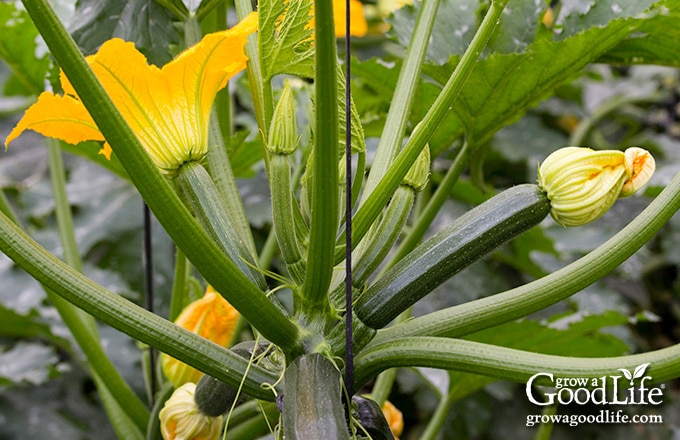
How to Grow Zucchini in Tomato Cage
Step 1: Plant the zucchini and summer squash. Either transplant seedlings or direct sow summer squash in a mound of soil.
Step 2: Add the tomato cage. Simply place a tomato cage securely in the ground when the zucchini and summer squash are young. Push the legs into the ground up to the first ring.
If you are using a flimsy tomato cage, hammer in a stake or long piece of rebar for extra support. Tie the tomato cage securely to the stake.
Step 3: Mulch the plants. Add organic mulch around the plants to help keep the weeds down, the roots cool, and conserve moisture. Keep the mulch a few inches away from the stem of the plant.
Step 4: Guide the zucchini and summer squash up. As the plant grows, gently direct the foliage and stem upward through the tomato cage. A few of the hollow stems do bend over the cage wires as the plant grows, but overall the benefits of growing summer squash vertically outweigh a few bent stems.

Growing summer squash vertically by trellising or in tomato cages helps to save space, encourages air circulation, and allows the squash to be more visible reducing the chance of overgrowth.
You May Also Like:
- 3 Easy Ways to Preserve Summer Squash
- Zucchini Garlic Bites Recipe
- DIY Self-Watering Containers
- How to Build a Square Food Garden
Good planning is key to a successful vegetable garden
Whether you are new to growing your own food or have been growing a vegetable garden for years, you will benefit from some planning each year. You will find everything you need to organize and plan your vegetable garden in my PDF eBook, Grow a Good Life Guide to Planning Your Vegetable Garden.
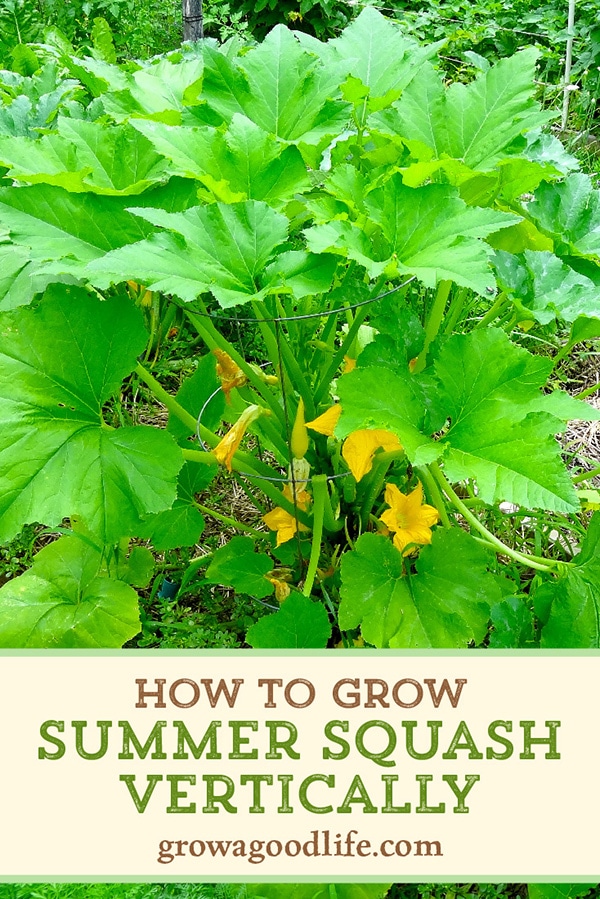


The bottom leaves of my zucchini are dead. Is this normal or am I doing something wrong?
Carolyn,
It’s not uncommon for the bottom leaves of zucchini plants to wither and die. These leaves are older and receive less sunlight and air circulation. The foliage is also in close contact with the ground allowing insects to hide and pathogens to splash on the foliage.
Go ahead and trim off the dead leaves, add a layer of mulch around the plants to prevent soil splash, and keep an eye on the plants for signs of disease.
Here is a great reference: Clemson Cooperative Extension – Cucumber, Squash, Melon & Other Cucurbit Diseases
How many seeds do you plant for every cage?
Janet, Each tomato cage can accommodate one plant. I usually sow 3 to 4 seeds, and then thin to the strongest plant.
I’ve done this with a volunteer plant and have yet to get it to set fruit. What’s wrong? The flowers keep falling off. I had one start to produce a squash and then it fell off when it was barely the size of a golf ball. What’s am I doing wrong???
Blossoms and young squash falling off the plant could be a pollination problem. Try hand pollinating: How to Pollinate Squash by Hand
I didn’t see this post until now…so it’s too late for this year to do. But I’m curious, as the zucchini plants grow up the tomato cage, do you need to support or “hammock” the squash?
Sylvia, Summer squash grow quickly and are best harvested young. With frequent harvests, you shouldn’t need to support the squash.
Can the summer squah be successful in a pot on an outside patio? The pot is big enough to put in a tomato cage (barely)?
Ida, Yes, you can grow summer squash in a container. You may need to trim the tines of the tomato cage so you can push it in deep. Also, make sure that the pot is large so it won’t tip oven if the squash plant gets top heavy. Let me know how you make out!
I love zucchini! This is a great way to grow it!
You said acorn and butternut were winter squash. I bought both along with zucchini and a straight neck squash. Will they still grow in zone 5 full sun or did I get took by the gardener? Great video. Thanks,
Dennis
Dennis, Yes, winter squash will grow in zone 5 full sun. I explain the difference between winter squash and summer squash in the article above under, “What is Summer Squash.”
wondering, what kind of spacing did you do with your vertical set up?
Erika, I still like to give zucchini and summer squash plenty of space even when growing vertically…at least 24-inches apart (4 squares in a square foot garden).
Thank you! I found your article because I had the same idea and wondered if it work, so I was doing a search – thank you for confirming that it works!
Cindy, I hope you give it a try!
It works great! We have done it for a few years now
Are the tomato cages right -sCide up with their stakes in the ground, or upside-down?
Catherine, The cages are in the ground the normal way with stakes in the soil to anchor them.